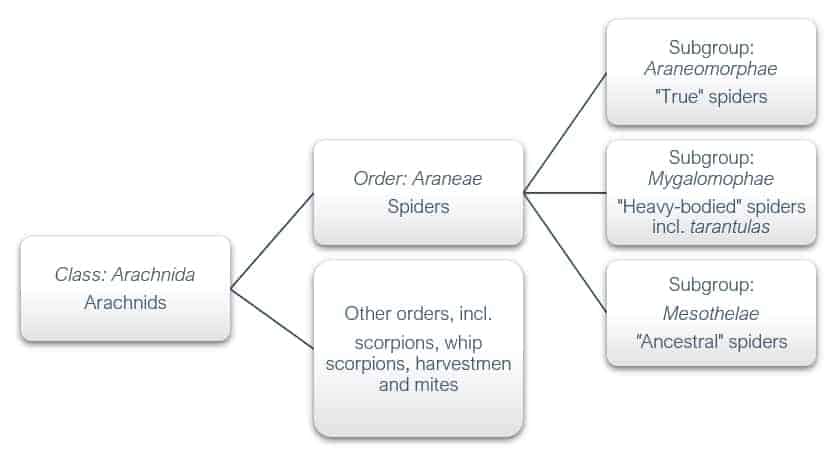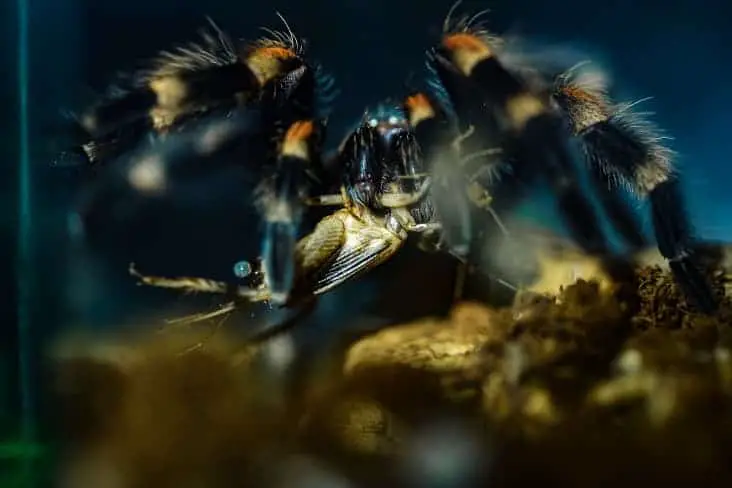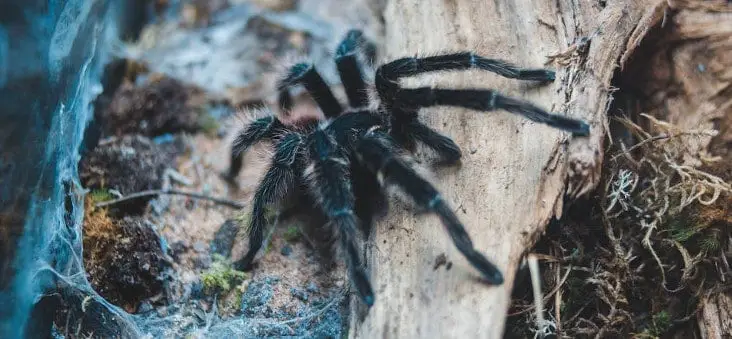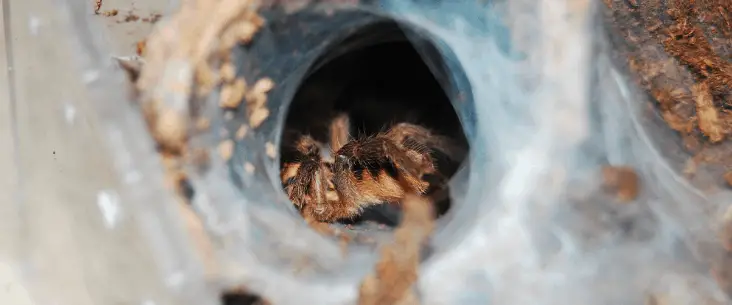Tarantulas are large, hairy, eight-legged creatures — often called giant spiders. Some people love them and can’t get enough of tarantula species as pets. Others will not use the words “love” and “fun” when talking about tarantulas. They think tarantulas are just creepy crawly big spiders. Although many people call them spiders, is a tarantula actually a spider?
All spiders, including tarantulas, belong to the order Araneae. However, the suborder Araneomorphs are considered “true” spiders, while the other spiders considered to be more primitive. Although tarantulas are not true spiders then, they belong to the spider family.
The naming convention makes it all a bit confusing. But there is even more on this topic. For example, tarantulas are also often called arachnids. Is this then the correct naming? Let’s take a look at the whole picture to find out!
So, we can consider a tarantula as a spider then?
Although tarantulas are not considered as “true” spiders, they belong to the order of spiders, which in turn belong to the class of arachnids. Confusing? Don’t worry; the answer is that they are absolutely spiders.
In the illustration below, we show how spiders are taxonomic is related to each other and other species. Tarantulas are considered heavy-bodied spiders which are more primitive compared to the subgroup Araneomophae.

It is also safe to say that a tarantula is an arachnid. All tarantulas, like all spiders (and many other arthropods in fact) belong to the Arachnida class. However, spiders are the largest order in the class of arachnids.
Within the order of spiders, there are over 47.000 species known and described, but probably there are even more species out there. The heavy-bodied spiders are far less in numbers than there “true” spider family. Approximately 900 species of tarantulas exist in the world. However, there are around 44.000 species of true spiders described today.
What is the difference between a tarantula and a “true” spider?
Now we know tarantulas belong to the order of spiders, but not considered “true” spiders, what are the differences between the two then. What differentiates tarantulas from other spiders.
The difference between them is mostly based on morphological features. Spiders within the suborder Mygalomorphae (the group including tarantulas) are generally heavily built with large jaws — officially called chelicerae. They also possess a “hairy” body, although it is technically not true hairs but covered with setae. Many of the species are quite large, compared to the many smaller “true” spiders.
Another distinctive difference is the alignment of fangs. The fangs of tarantulas are nearly parallel in alignment, where spiders within the order Araneomorphae having fangs that slope towards each other.
The lifespan of Mygalomorphs is generally much longer than those of Araneomorphs. Where tarantulas often live for 10 years or longer, many Araneomorphs die after one year.

Tarantula facts: What is unique on these spiders?
Although there are far more true spiders out there than there are tarantulas, tarantulas are still more favoured to be kept as a pet. There are many reasons for that, but it is also because of their uniqueness, even a little bizarreness, that make tarantulas favoured amongst many people (and the worst nightmare of others). Let’s talk some tarantula facts!
- Tarantulas have a venomous bite, but it doesn’t produce a toxin that is strong enough to injure or kill a human. You can better compare a bite with a sting of a bee. The (bad) reputation of tarantulas is more based on legend than reality. There are only a few tarantulas which have a powerful bite or are more toxic. Generally, they belong to the ‘old world tarantulas’. Tarantulas are actually quite harmless and peaceful, and only attack if feeling threatened.
- The name for tarantulas originates from Southern Italy. In the town of Taranto was a species of spider living (the European wolf spider (Lycosa tarantula), which is actually unrelated to what we know name tarantula), where legend claims that a bite from this spider causes a disease called tarantism that was fatal. There was only one cure: You needed to dance until exhausted so that the poison would have been sweated out of your body. The dance is called ‘Tarantella’. Nowadays, however, studies showed that a bite does not cause severe symptoms and is compared to a bite of tarantulas.
- Tarantulas have quite a range of defence mechanisms. Some tarantulas will use a threatening pose, where it will simply lean on the back legs, raising its head and front legs and expose its curved fangs. This posture is an intimidating display to scare off the predator. Many tarantulas use to rubbing and scrape off their “hair” on its back (abdomen). Each hair is covered with tiny points and barbs. These detachable hairs are propelled against the predator and will induce an unpleasant itch, especially when it comes in contact with soft tissue and eyes. And then there is their bite, which is venomous and of small(er) animals rather painful.
- Even with 8 eyes, tarantulas have a relative poor eye-sight. They can distinguish light and dark, and recent studies show that they can see colours to some extent. However, tarantulas trust more on their hairs — called bristles — to sense and “see” their environment. They can sense the slightest vibration of the ground and can determine if it is a predator or prey. When sensing a predator, it will quickly retreat to its hide. In the case of prey, it will wait until it is close enough to ambush it.
- Tarantulas don’t use webs like “true” spiders do and don’t catch prey in a web. However, they still use silk to detect prey. Tarantulas set up lines around their hide. When a juicy insect passes by, touching these lines will cause vibration that is detected by the spider. Although tarantulas don’t make classical webs, they use their silk for many other purposes. One way that they use silk is to climb slack surfaces. Tarantulas can produce small amounts of silk in each of their eight legs, which makes them even able to climb class walls (quite an achievement with their heavy body). Also, very fine adhesive hair-brushes on the tip of their legs help them climb vertically. Many tree-dwelling tarantulas locate a mate by following the silken trail that the female leaves as she moves around.
- When prey is close enough it pounces on it quickly bite it with its venomous fangs. Tarantulas don’t have teeth and can’t chew their food. The mouth is more shaped like a straw tube. To feed on prey items, they inject digestive juices into their prey to liquefy their food. When it is soft they will easily suck it up.
- Where Araneomorphs (true spiders and often smaller) only live for one year, tarantulas can become quite old. Typically male tarantulas live between 5 and 10 years. Females, however, can live over 20 years. For some tarantula species, it is even believed females can become 40 up to 50 years. Science has not found a definitive answer on this because it is difficult to track individuals in the wild for such a long period.
- Many tarantulas are colourful. Because these spiders are quite unique, among other factors, they are very popular to be kept as a pet. As a consequence of collecting tarantulas, together with habitat destruction and climate change, some tarantula species have become endangered. For example, the very popular and beautiful Mexican red-knee tarantula (Brachypelma smithi) is now threatened and classified as a protected species. By law, it is restricted to be internationally traded.

What types of tarantulas are there?
As today, there are around 900 species of tarantulas. Although they have common features in terms of body plan and appearance, there are different types of tarantulas. When you have searched for tarantulas before, of when you have been to a (online) pet shop, you have probably read the terms old world and new world tarantulas. And what about arboreal and fossorial species?
Old world tarantulas vs. New world tarantulas
Often people refer to tarantulas if it is an old world or a new world species. But what is the difference?
It is the origin of the tarantula species which determines whether it is classified as an old world species or a new world species. Old world species are tarantulas that live in the eastern hemisphere. This includes Asiatic, African, Australian and European tarantula species. New world species live in the western hemisphere, that is in North America or South America.
Because the tarantula separated a long time ago and evolved separately including with different climate, habitats and food availability, they each have their own traits what makes them quite different.
Generally, new world tarantulas are more slow-moving tarantulas and more tolerant, where old world tarantulas a much faster, highly defensive and will attack much quicker. Of course, there are exceptions within both classes.
Terrestrial, arboreal and fossorial tarantulas
Then there is a difference in terrestrial, arboreal and fossorial tarantulas. This is a classification more based on the way they live.
Terrestrial species are ground-dwellers, living on the bottom substrate and use shallow hides from where they wait for passing prey to ambush. Typically, they don’t web much and there presence is not really notable.
Arboreal species are tree-dwellers. These tarantulas live in trees and plants above the ground. These tarantulas like to climb and won’t be seen on the ground much often. These spiders generally web a lot and like to hide in cracks and holes within trees, but creating a hide with webbing is also very common. These spiders are often quite fast-moving and sometimes a bit skittish.
Fossorial are burrowing species, which like to make a burrow/hide far below the surface. They dig a nice burrow in the substrate where they will be most of the time. Fossorial species don’t come out that often, but their presence is generally a bit more notable.
Find out more about tarantulas?
If you like to know more about tarantulas, have a look at the introduction to the biology of tarantulas. Also, I have a whole section with articles about these amazing spiders!
Interested in keeping a tarantula? Tarantulas make quite amazing pets. Although not suitable for everyone, these spiders are quite easy to keep when you take some time to understand the basic needs. If you wish to start keeping them, I can recommend you to read the article with basics on keeping and caring for tarantulas.
Share this page!



